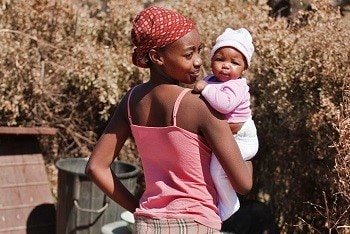Breastfeeding, HIV-Infected Mothers Given Choice of Treatment
University of North Carolina at Chapel Hill, Prevention Research Center

A scientific article reporting the research results and published in the New England Journal of Medicine received the 2011 Charles C. Shepard Science Award in the category of prevention and control. This achievement exemplifies what can be achieved through the PRC model—particularly in how it enables CDC researchers to work closely with external researchers.
Background
In the developing world, use of infant formula is expensive and associated with increased infant deaths. The World Health Organization (WHO) recommends exclusive breastfeeding even for infants of HIV-positive mothers in resource-limited settings. Each year about 200,000 infants worldwide become HIV-infected during breastfeeding.1 Unless treated, half of these infants die before their second birthday.
Context
Annually, more than 90% of HIV infections in children occur in sub-Saharan Africa. Most of these infections occur because of virus transmission from infected mother to child during pregnancy, delivery, or breastfeeding.2 Use of antiretroviral drugs during pregnancy and delivery are highly effective interventions to prevent transmission, but whether drug therapy prevents HIV transmission over many months of breastfeeding has been unknown.
Results led the WHO to recommend giving mothers a choice of approaches to treatment.
Methods & Results
In the Breastfeeding, Antiretrovirals, and Nutrition (BAN) Study, pregnant HIV-positive women from Lilongwe, Malawi, who had not developed AIDS and whose CD4+ lymphocyte count was ≥250 cells per cubic millimeter were eligible for the study.1 Enrollment started in 2004, and ultimately 2,369 breastfeeding mother-infant pairs were randomly assigned to one of three study groups:
- Maternal regimen group: mothers took three different antiretrovirals twice a day for up to 28 weeks post-partum.
- Infant regimen group: mothers gave their babies a single daily dose of a liquid antiretroviral for up to 28 weeks post-partum.
- Control group: mothers and infants received standard antiretroviral therapy during labor and delivery and for seven days post-partum.
Mothers were asked to wean their babies by 28 weeks after birth.
The study’s protocol was approved by the Malawi National Health Science Research Committee and institutional review boards at the University of North Carolina and CDC. All women provided written informed consent.
The risk of HIV transmission to the infant between 2 and 28 weeks post-partum was 6% in the control group, 3% in the maternal regimen group, and 2% in the infant regimen group, signifying that the efficacy of the 2 regimens was 53% and 74%, respectively. The risk of infant death among the 3 groups was similar. Serious drug reactions were slightly more common for women receiving the maternal regimen than for babies receiving the infant regimen.
Consequences and Potential Impact
In November 2009, WHO released new recommendations on breastfeeding by HIV-positive mothers living in low-resource settings, based on evidence that included results from the BAN study. For the first time, WHO recommended that HIV-positive mothers or their infants take antiretroviral drugs throughout the period of breastfeeding. By following one of these regimens, children can benefit from breastfeeding while reducing the risk of mother-to-child HIV transmission.3
By integrating services for the identification, care, and treatment of HIV-infected women and their infants, implementation of these new prevention strategies in the developing world offers a unique opportunity to link prevention and treatment.2
Additional analyses of data from the BAN study continue, including an evaluation of high-calorie food supplementation for mother and child during breastfeeding and weaning.
References
- Chasela CS, Hudgens MG, Jamieson DJ, et al. Maternal or infant antiretroviral drugs to reduce HIV-1 transmission. New England Journal of Medicine. 2010;362:2271–2281.
- Mofenson LM. Protecting the next generation – eliminating perinatal HIV-1 infection. New England Journal of Medicine. 2010;362:2316–2318.
- World Health Organization. Antiretroviral Drugs for Treating Pregnant Women and Preventing HIV Infection in Infants: Recommendations for a Public Health Approach—2010 version website. http://apps.who.int/iris/bitstream/10665/75236/1/9789241599818_eng.pdf [PDF – 1.15MB]. Accessed November 29, 2018.